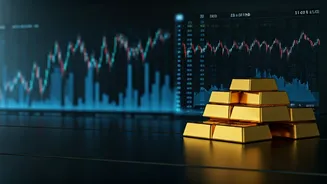Economic Anxieties Surge
The global financial landscape is currently painted with uncertainty, and this is a significant driver of gold's price increase. Several factors contribute
to this unease. One of these is the persistent shadow of economic slowdowns in major economies across the globe. Investors, naturally wary of potential downturns, often turn to gold as a secure investment to safeguard their wealth during troubled times. The precious metal is widely regarded as a 'safe haven' asset, which means it tends to hold or even increase its value when other assets, such as stocks, experience declines. Furthermore, geopolitical tensions play a critical role. Instability in international relations can lead to greater uncertainty in financial markets. Consequently, investors flock to gold, perceiving it as a reliable store of value when the future is unpredictable. Economic and geopolitical instability often go hand in hand, magnifying the impact on investment decisions and thereby significantly affecting gold prices.
Inflationary Pressures Mount
Inflation is another significant catalyst behind the current gold price surge. When inflation rises, the purchasing power of money decreases. As a consequence, investors seek assets that can maintain or enhance their value in real terms. Gold has historically served this role well. Many investors view gold as a hedge against inflation. This means that they expect gold's value to increase alongside rising inflation, thereby protecting their wealth. The expectation of persistent inflation, whether driven by supply chain disruptions, rising energy costs, or expansionary monetary policies, often prompts investors to purchase gold. Additionally, when inflation rises, real interest rates – the difference between nominal interest rates and the inflation rate – tend to fall. Lower real interest rates often make gold more attractive to investors, as the opportunity cost of holding gold (which does not provide any interest) decreases. The combination of inflation expectations and low real interest rates creates a favorable environment for gold, pushing prices upward.
Investor Strategies Shift
Changes in investment strategies are also contributing to the ascent of gold prices. Institutional investors, such as hedge funds and investment banks, significantly influence market trends. These entities have lately been increasing their gold holdings as part of their diversified investment portfolios. This increase in demand from institutional investors, who often have substantial buying power, can have a noticeable effect on gold prices. Furthermore, individual investors are also playing a crucial role. Increased interest from retail investors, driven by the desire for diversification and protection against market volatility, amplifies the demand for gold. Online trading platforms and the availability of gold-backed exchange-traded funds (ETFs) have made it easier than ever for individual investors to participate in the gold market. Consequently, the combined effect of institutional and individual investor interest creates a robust demand, which supports price increases. The shift towards gold, as a strategic investment, has a compound effect on its price.
Currency Devaluation Worries
Concerns surrounding currency devaluation are also fueling the demand for gold. When a country's currency loses value compared to other currencies, it can lead to higher prices for imported goods, contributing to inflation. Gold, being globally recognized and priced in US dollars, often becomes more attractive in such scenarios. Investors seek to protect their wealth by converting their holdings into gold, seen as a more stable asset. This trend is particularly evident in emerging markets, where currency fluctuations can significantly impact investment returns. Furthermore, governments and central banks may also hold gold as a reserve asset to diversify their portfolios and hedge against currency risks. The perception that a currency is losing value increases the attractiveness of gold, further pushing prices up.
Supply and Demand Dynamics
The fundamental laws of supply and demand significantly influence gold prices. Although the supply of gold is relatively constant, demand is subject to considerable variation. The recent surge in prices reflects a higher demand than supply. Mine production, the primary source of gold supply, grows steadily but is slow to respond to rapid increases in demand. When demand outpaces the available supply, prices naturally go up. Factors affecting supply include exploration discoveries, extraction costs, and government policies. On the demand side, investment, jewelry consumption, and industrial uses contribute. Increased investment demand, stemming from safe-haven considerations, inflationary hedges, and portfolio diversification, amplifies the imbalance, further driving up prices. Changes in these fundamental economic principles impact gold's pricing.
Geopolitical Event Impacts
Geopolitical events exert a strong influence on gold prices, often triggering sharp price movements. Major conflicts, political instability, and heightened international tensions often cause investors to seek safe-haven assets, such as gold. When uncertainty rises, investors flock to gold, resulting in increased demand and prices. The impact can vary depending on the severity, duration, and global implications of these events. For example, events that increase global economic uncertainty, such as military conflicts or trade disputes, can significantly boost gold prices. Conversely, events that promote stability and optimism might lead to a decrease in the demand for gold, moderating prices. Geopolitical developments, therefore, are critical to consider when analyzing gold price trends.







